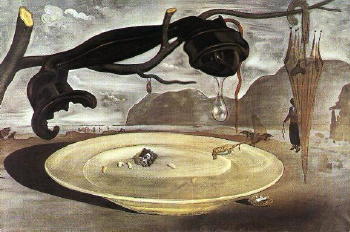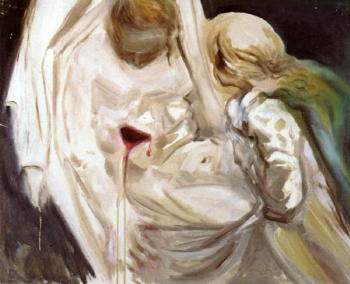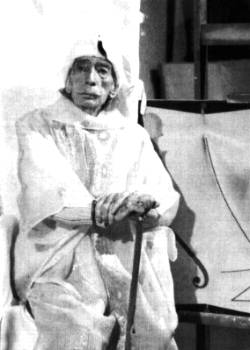I’ve been incredibly busy and incredibly absent, both mentally and physically. Yesterday I accompanied guests to see the Dal? exhibit for the second time, which was good, because there’s so much there I had to hurry through the last half of the exhibit the last time. I mean the first time, because the first time was the last time. (But now the second time is the last time.)
A problem with analyzing Dal? is that anything he did can be made the subject of much conjecture and interpretation, none of which can be satisfactorily resolved. That’s because the nature of surrealism is that the artist usually has at best only a fuzzy idea of what his art depicts, and the meanings are even less clear.
You’d almost have to be a shrink. And as we all know, shrinks are notorious for being wrong. Interestingly, Dal? and Freud hooked up late in Freud’s life. I think it’s fair to say that Dal? was more fascinated with Freud than vice versa, as Freud was no fan of surrealism.
Until (in 1938) he met Dal?:
This fantastic meeting between Dali and Freud, which took place in London in 1938, was one of the most important in Dali?s life. Dali considered Freud one of the most vital influences in his life and on his art. The surrealist had considered Freud their patron saint. Dali had unsuccessfully tried to set up meetings with Freud in Vienna. In London, Dali was finally successful in arranging a meeting through the intervention of a mutual friend.
Freud was always of the opinion that the surrealists were “complete fools.” His taste was classical and Freud was not easily dissuaded from his opinions not to mention that he was very resistant to meet with a man he considered a “lunatic.”
The meeting was a significant one. Dali claimed that the founder of psychoanalysis, as a result of their encounter, was forced to reconsider his view of Surrealism. Freud wrote “that the young Spaniard with his fanatical eyes and his undeniable technical mastery” did indeed change his view of modern art. Freud recognized in Dali a combination of passion and control, which he himself also possessed.
What most fascinated me was Freud’s statement (on display at the Museum) that while our reaction to classical art is to search for the emotional, our reaction to surreal art is to search for the rational.
This can create problems when the surreal meets the political. Political surrealism is contradictory, because politics takes itself so seriously that surrealism is abhorrent. Manipulation of the emotions (by clever dissembling of the manipulation istelf!) is the stock in trade of politics. Surrealism, a direct nosedive into the emotions and the unconscious, would almost seem to be at war with politics. Yet the surrealist movement had a distinctly leftist bias, and Dal? was criticized for not leaning to the left. (Whether his leanings were genuinely towards fascism is much open to debate, although I think the inherently chaotic and uncontrollable nature of his art is at once anti-communist as well as anti-fascist.)
Hunter Thompson warned of the danger of artists becoming involved with politics. And of course, we know that Hitler was an artist, although a rational one whose tastes in art were undoubtedly more in line with Freud’s than Dal?’s.
One of the things I did yesterday was to attempt to unfocus my mind as I focused on one of Dal?’s most controversial paintings — The Enigma of Hitler.

Here’s the view of the Dali exhibit’s curator:
ASK: Would you say that The Enigma of Hitler is a political painting?
MT: I would say that’s probably one of the greatest damnations of fascism that I’ve ever seen. Hitler, if you notice in that painting ? which of course the Surrealists interpreted as being, “Oh, he’s glorifying Hitler” ? is a scrap of a magazine…He’s in the middle of a plate with boiled beans, and the plate is sort of circular, almost like he’s being flushed down a toilet, and all around him are bats, images of Chamberlain’s umbrella. It’s gloomy, that room is incredibly gloomy. This is Dal? realizing that, unfortunately, what he was predicting in 1934 is actually happening. Hitler’s going to invade Poland, he’s going to take Czechoslovakia, and it’s going to lead to a world war. And Dal? hated that because we also have this idea of artists being heroic like Hemingway, but Dal? was a coward. Dal? didn’t want to fight. He really felt that European and, indeed, worldwide civilization would come to an end with a world war. He really thought that was Hitler’s aim: to destroy everything and be killed with Wagner playing in the background. So I find that a very moving painting. I think it’s the damnation not just of the Munich Pact, although that was clearly referred to in the telephone being disconnected, but also I think it’s kind of about the end of his life as he knows it. In the next year, he’s expelled from the surrealist group.
The painting is gloomy and grim. Drab colors, and the focus is on Hitler’s plate, which has only a few beans. It’s being fed by bat drippings and by the broken telephone. Notice that the earpiece is shattered while stuff drips from the receiver and the cut cord. Clearly, there’s talk, but no one is listening. Chamberlain’s umbrella is both meaningless and devoid of substance. You can see through it. The dead branch is described as an olive branch. Peace is dead, Hitler is hungry. The bats of peace (dare I say “moonbats”?) are feeding him. Peace is dark, and war is inevitable.
At least, that was my interpretation of it. I’m unable to discern any sympathy for Hitler, although I suppose that any attempt to understand him might be seen that way by Communist sympathizers. The latter often forget that the Communist strategy towards Hitler (aka the Molotov-Ribbentrop Pact) was even worse than appeasement; it bordered on an outright alliance, and mutual engulfing and devouring of helpless countries. At any rate, Communism is forgiven, and to dwell on its horrors risks a charge of redbaiting.
I was also intrigued by the enigma of Dal?’s last painting — The Swallow’s Tail (1983) — in which I think the artist anticipates his own death:

When he painted that, Dal? was 79, his wife Gala had died the year before, he’d been diagnosed with Parkinsonism, and he was to become seriously burned the next year in a fire in his home which some have called a suicide attempt. The painting’s ostensible theme is catastrophe, and it is part of a series he did partly in homage to Rene Thom, the father of catastrophism:
It studies and classifies phenomena characterized by sudden shifts in behavior arising from small changes in circumstances.
Catastrophes are bifurcations between different equilibria, or fixed point attractors. Due to their restricted nature, catastrophes can be classified based on how many control parameters are being simulataneously varied. For example, if there are two controls, then one finds the most common type, called a “cusp” catastrophe. If, however, there are move than five controls, there is no classification.
Thom’s theories of course remain controversial, but the respected Economist concedes their possible ongoing value:
Mr Thom’s theory may have been treated unfairly. It was philosophical as much as mathematical. The theory continues to be cited occasionally in discussions of how catastrophes have suddenly intervened to reshape history. Mr Thom was keen to explain how the theory worked in the history of his own country. The French revolution was the big bang of catastrophe theory, he said, and its effects had not yet been exhausted.
Dal?’s Topological Abduction of Europe – Homage to Rene Thom, also painted in 1983, applies catastrophic theory to Europe, although again, it’s tough to interpret. I’d hate to think Dal? was being prophetic again, but here it is:

If Europe is cracked because of catastrophe, how and why? I guess this was left open to futuristic interpretations, but when was the future? I hope it’s not now, as I’d avoid it like hell.
Avoiding the future? That may be the real theme of Dal?’s last painting. Notice that the edge of the canvas is dark, but there’s a white sheet tacked over it.
An obvious coverup? By death? Of hidden mysteries?
The tacks are crudely obvious, and while neat mathematical chaos (a contradiction if ever there was one) overlays the sheet, there’s no way to avoid the figure underneath. I can barely see the bent, frail, knee on the right which exists in so many of his paintings. Is the figure Dal?? Is it a butterfly? (The Swallowtail is a butterfly, and Dal? likens himself to a butterfly in this interview.) The butterfly is of course the end stage of life, as well as the beginning (assuming reproduction is that.)
I think it’s fair to conclude that for most of us, death is the ultimate catastrophe.
Consider another painting done the same year, Pieta.

I suspected the sheet was a shroud symbolizing death, but in my mind Pieta confirms it.
Like Dal?, the future remains under a shroud.
We’ll never be able to pull it off.
Not now.
UPDATE: I found a picture of Dal? in his last years, posing in front of his last painting (The Swallow’s Tail). What really stands out in this photo is not only Dal?’s shround-like attire, but the apparent piercing of the shroud-like canvas. Because of the way the painting is cropped, it really looks as if the catastrophe graph has pierced it, (echoing Pieta again, I think), even though it’s just painted on.

Style meets and greets death?
Comments
5 responses to “Art to die for?”
I’m intrigued by the “Swallow’s Tail”.
It would almost seem that Dali spent some time studying higher mathematics. At least, the elongated-S symbols play a large role in Calculus, and the other curves could be related to various functions…
Sometimes I’m distracted by minor details:
Freud was “very resistant” to meet with a lunatic? But, but wasn’t he…didn’t he…we’re talking about Freud, the famous Freud? Not John Freud or Chuck Freud, but Sigmund Freud, right?
Extremely interesting. How could that painting conceivably be seen as glorifying Hitler? I’ve seen plenty of Nazi art (National Socialist Realism, if you will) and it’s the opposite in every way. One look and Hitler would have instantly concluded that Dali was a Jew.
Swallow’s Tail is quite beautiful. Ayn Rand hated most modern art (though she loved modern architecture), but she rather liked Dali. He had “a revoltingly evil metaphysics” but “a luminously rational epistemology”. Most interesting.
Myself, I have always loved abstract art, e.g., Kandinsky, Mondrian, Vassirely, and Dawn loves the square style of Mondrian, but Norma likes only representational art, as in the style of the Egyptians or of the Mayas. Both agree that the purpose of art is to glorify God and the Goddess, the Gods and the Goddesses. Godless Communism must be destroyed.
Communism and Nazism are the same thing. I know that Communists and Nazis hate to hear that. I’m glad. As President Reagan said at the end of his reign: “I am proud to say that I am still an anti-Communist.”
Dali is not as easily dismissed by classicists as many modern artists or surrealists. His solid grounding in classical art never left him, and he would occasionally turn out Old Masters style paintings as a reminder. He tried to depict his hallucinations literally and accurately.
Yes it was Sigmund Freud, and I can see why he’d have liked Dali, and why Rand would have too.
Actually, I find this post fascinating and stunning photo?s.
My interpretation is as follows:
The thema in the Swallow?s Tail:
XPI = jesu xpi passio = XPI = greek symbol of Christ?s death
XPI is superimposed over the X plus invert triangle = Chalice
Musical themes = violin, clefs all painted on white shroud,
The piercing of the shroud theme = crucifixion and the rending of the temple veil.
Go back and look for the XPI. Its there.
Second interpretation of photo of Dali next to painting. Dali is clearly dressed as the clown, Pagliacci from the Opera. Therefore we see visually the musical themes, Pagliacci, Vesti La Guiba, and the associated subjects of death, betrayal, loss of beloved, the grandeur of life-death, old age, resurrection (creation). Then Dali gives us the facial look and shows his great artistic hands, old but unbowed.
Lots of subject matter here for a long essay.
To be brief, I quote only the English translation of Vesti la Guibba:
Go on stage, while I’m nearly delirious?
I don’t know what I’m saying or what I’m doing!
And yet, chin up! I’ll try harder. Bah, you think you’re a man? You’re just a clown! On with the show, man, and put on your white-face. The people pay you and you must make them laugh. And if Harlequin should steal your Columbine, laugh, you’re Pagliacci, and the world will clap for you! Turn into banter all your pain and sorrow, and with your clowns’ face hide grief and distress… Laugh loud, Pagliacci, forget all of your troubles, Laugh off the pain that so empoisons your heart.
Dali is saying life imitates art, art imitates life.
To the end Dali is defiant and creative.
?Surrealisme ? Je suis surrealisme ?.
McKiernan (Catch 22)